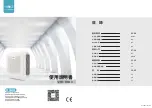
11
■
English
Facility Setting
(cooling at low outdoor temperature)
This function is limited only for facilities (the target of air conditioning is equipment (such as computer)).
Never use it in a residence or office (the space where there is a human).
Cutting jumper 6 (J6)
on the circuit board will extend the operation range to 14°F (–10°C). Installing an air direction
adjustment grille (sold separately) will further extend the operation range to –4°F (–20°C).
In these cases, the unit will
stop operating if the outdoor temperature falls below –4°F (–20°C), restarting once the temperature rises above this level.
1) Remove the top plate of the outdoor unit. (09/12 class: 3 screws, 15/18/24 class: 6 screws)
2) Remove the front plate. (09/12 class: 4 screws, 15/18/24 class: 8 screws)
3) Cut the jumper (J6) of the PCB inside.
CAUTION
• If the outdoor unit is installed where the heat exchanger of the unit is exposed to direct wind, provide a windbreak wall.
•
Intermittent noises may be produced by the indoor unit due to the outdoor fan turning on and off when using facility settings.
• Do not place humidifiers or other items which might raise the humidity in rooms where facility settings are being used.
A humidifier might cause dew jumping from the indoor unit outlet vent.
•
Cutting jumper 6 (J6) sets the indoor fan tap to the highest position. Notify the user about this.
Pump Down Operation
In order to protect the environment, be sure to pump down when relocating or disposing of the unit.
1) Remove the valve cap from the liquid stop valve and gas stop valve.
2) Carry out forced cooling operation.
3)
After 5 to 10 minutes, close the liquid stop valve with a hexagonal wrench.
4) After 2 to 3 minutes, close the gas stop valve and stop forced cooling operation.
5) Attach the valve cap once procedures are complete.
Gas
stop valve
Valve cap
Hexagonal
wrench
Close
Liquid
stop valve
Service port
Forced cooling operation
[For FFQ and FDMQ models]
Using the indoor unit’s remote controller
[For wired remote controller]
1) Set to COOL operation using the remote controller.
2)
Press and hold the Cancel button for 4 seconds or longer.
Service settings menu is displayed.
3) Select
Test Operation
in the service settings menu, and press
the Menu/OK button. Basic screen returns and “Test Operation” is
displayed at the bottom.
4)
Press the On/Off button within 10 seconds, and the forced cooling
operation starts.
•
Forced cooling operation will stop automatically after about 15
minutes. To stop the operation, press the On/Off button.
Basic screen
1)
2)
Cool
Return
Clean the filter
Set to
Cool
68
F
Press and hold the Cancel
button for 4 seconds or
longer during backlight lit.
Service Settings
menu screen
3)
Setting
1/3
Service Settings
Test Operation
Maintenance Contact
Field Settings
Energy Saving Options
Prohibit Buttons
Min Setpoints Differential
Press the Menu/OK button.
4)
Set temperature
80
°F
Cool
Test Operation
Press the On/Off button
(within 10 seconds).
01_EN_3P500432-2B.indd 11
10/30/2018 11:53:03 AM
































